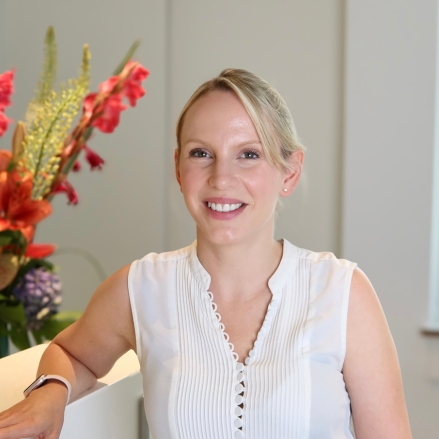Your team of experts
Facts on Abdominoplasty
| Treatment methods | Incision in abdominal area, around the hours | /wp-content/uploads/2025/10/medical.svg |
| Anaesthesia | General anaesthetica | /wp-content/uploads/2025/09/time-1.svg |
| Aftercare | Supporting garment, bandages, check-ups after 10–12 days, 6 weeks, 6 months and 1 year | /wp-content/uploads/2025/09/stethoscope-medical-tool.svg |
| Removal of sutures | Absorbable sutures used | /wp-content/uploads/2025/10/medical.svg |
| Presentable | after 2 - 6 days | /wp-content/uploads/2025/09/meeting.svg |
| Costs | From 8,200 € plus anaesthetic, clinic and accommodation costs | /wp-content/uploads/2025/10/coin-stack.svg |
Abdominoplasty
In our society, a firm, toned stomach is very much part of our ideal of beauty. However, many people find it difficult to achieve their wish of a toned core without professional help. There are many reasons why a person’s stomach might slacken, such as past pregnancies or simply the natural ageing process. Significant weight loss can also result in excess skin that is unable to form back of its own accord.
We offer our patients abdominoplasty – often referred to as a tummy tuck – as an effective solution to slackened skin. Abdominoplasty is a surgical procedure in which excess skin and fat tissue is removed from the stomach area. The abdominal wall is gently tightened, resulting in a harmonious overall image.
If you have any queries about abdominoplasty, get in touch with us here at Central Aesthetics. Arrange a non-binding appointment for a one-to-one abdominoplasty consultation to assess your individual case.
Frequently asked questions on Abdominoplasty
What exactly is abdominoplasty?
Abdominoplasty, sometimes referred to as a tummy tuck, is a surgical procedure to tauten and shape a person’s lower torso. Excess tissue is surgically removed from the stomach and waist area, restoring a slimmer, aesthetic silhouette to the body.
Abdominoplasty allows us to counteract a variety of aesthetic imperfections. The surgery is primarily suitable for restoring a firmness to the abdominal wall following a pregnancy or weight loss. As we get older, our skin loses its elasticity and becomes unable to form back into shape after being overstretched. If regular exercise and cosmetic treatments can’t provide the desired results, abdominoplasty can be an effective solution for those affected.
It’s also an effective remedy for stretch marks, cellulite and small fat deposits. If required, and depending on your individual situation, we may be able to combine the procedure with liposuction or treatment to firm up the abdominal muscles. We can also remedy other marks during the procedure if necessary, such as scars resulting from a Caesarean section.
What abdominoplasty methods are there?
We use a range of techniques to tauten the abdominal area depending on the degree to which the skin has slackened. The most common method is classic abdominoplasty. In this procedure, excess tissue is removed from the lower and middle abdomen via incisions in the skin. It may also be necessary to lift the abdominal wall and temporarily detach the skin around the navel to do so. After the abdominal area has been tautened, the navel is reattached in its original position.
Classic abdominoplasty is a procedure which takes several hours and is performed under general anaesthetic. Patients remain in the clinic overnight after the procedure, and are then free to return home the following day.
If only small amounts of tissue are to be removed, in some circumstances we might perform a so-called mini-abdominoplasty instead. This is a more minor procedure to tauten the abdominal floor without relocating the navel. Mini-abdominoplasty primarily involves removing tissue from the lower abdomen below the navel. Local anaesthetic is generally sufficient for this smaller procedure.
What happens before abdominoplasty?
Procedures to tighten the abdomen are individually structured for each patient. This allows us to work purposefully to achieve the patient’s desired results. In a consultation appointment, the doctor treating you will explain the treatment’s prospects and the risks involved. They will then work with you to decide on how to proceed.
Before abdominoplasty itself, it’s important to carry out a blood test. We might perform further examinations if a patient has existing conditions or illnesses. The doctor will also use the one-to-one consultation to ask about any intolerances or medication you’re taking.
There is no specific preparation required for the operation itself. However, to make sure it proceeds smoothly, there are a few basic rules. For example, you should temporarily stop taking any medications which could impair blood coagulation. You should also avoid alcohol and nicotine for two weeks prior to the operation.
What exactly does abdominoplasty involve?
Abdominoplasty is generally an inpatient procedure carried out under general anaesthetic. However, local anaesthetic is usually sufficient for mini-abdominoplasty. First of all, the surgeon marks out on the skin which areas are to be treated. The anaesthetic is then administered.
Next, the surgeon makes the incisions at the specified locations above the pubic region. Making the incision here allows the surgeon to lift the abdominal floor and temporarily detach the navel. After removing the excess skin and fat tissue, the doctor fixes the navel back in its original position. The procedure of mini-abdominoplasty is essentially the same, but less extensive. It also leaves the navel untouched.
After the procedure, the surgical wounds are fitted with drains and are sutured. These drains ensure that blood and other secretions from the wound can flow out of the body unhindered. Finally, a bandage and compression garment is placed on the patient, who can leave the practice the following day.
What do I need to consider after abdominoplasty?
The results of abdominoplasty will be checked at regular intervals. The adhesive bandage remains in place until the first such check-up, after around 8–10 days. A special compressive garment is also worn for the first 4–6 weeks after surgery. Any initial complaints, such as a feeling of tightness or slight wound pain, usually disappear fairly quickly.
It’s important to protect the areas treated, which is why you should avoid any intensive or strenuous physical activities in the first 3–4 weeks after surgery. Depending on your profession, it may be around 2 weeks before you’re ready to return to work. It will also take some 8–10 days for you to be socially presentable again.
What side effects can be expected following abdominoplasty?
Slight pain and feelings of tightness can sometimes develop for a short time following the procedure. Such symptoms are entirely normal, and normally subside after a few days. Nevertheless, you can take painkillers during the healing process if you wish.
How long do the results of abdominoplasty last?
The results of abdominoplasty are long-lasting. Nevertheless, it’s possible that the tissue in this area could slacken again if you gain weight or fall pregnant.
What are the risks in abdominoplasty?
Like all surgical procedures, abdominoplasty does involve a certain degree of risk. These risks include, for example, thrombosis and fat embolisms, alongside general surgical and anaesthetic risks. What’s more, in some rare cases infections or wound healing deficits may develop.
Does abdominoplasty result in visible scarring?
Abdominoplasty involves making incisions in the skin, which means that scarring cannot be avoided. However, where possible these incisions are placed in locations where they’ll be hidden by underwear or bathing suits when healed. It can take up to 1.5 years for surgical scars to heal completely.
How much does abdominoplasty cost?
The cost of abdominoplasty can vary significantly depending on the scope of treatment. At Central Aesthetics, we perform abdominoplasty for around €8,200 plus anaesthetic, clinic and accommodation costs.
Start your journey with us here

Reviewed by Dr. Robin Deb
Dr. Deb is a specialist in plastic and aesthetic surgery and founder of Central Aesthetics. Thanks to his many years of expertise, the specialist has extensive medical knowledge. The information presented on this page has been personally reviewed by Dr. Deb and is based on the highest medical standards in plastic and aesthetic surgery.
Pay for treatment in installments?
Central Aesthetics
by Dr. Deb
Opening hours
| Monday | 9:00 a.m. – 6:00 p.m. |
| Tuesday | 9:00 a.m. – 6:00 p.m. |
| Wednesday | 9:00 a.m. – 6:00 p.m. |
| Thursday | 9:00 a.m. – 6:00 p.m. |
| Friday | 9:00 a.m. – 6:00 p.m. |
and by appointment
You are currently viewing a placeholder content from Default. To access the actual content, click the button below. Please note that doing so will share data with third-party providers.




